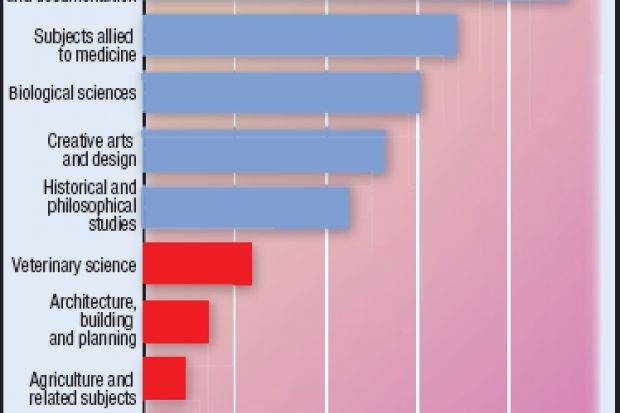Recruitment of international students is not only helping to shore up the finances of UK institutions, it is also providing a vital prop for many "strategic" subjects such as engineering, mathematics and some science subjects, a sector-wide analysis has found, writes Tony Tysome.
The number of overseas students enrolling on courses at UK institutions more than doubled over the ten years from 1996-97 to 2005-06, growing to more than 223,000.
This expansion has brought significant financial benefits, according to the annual Patterns of Higher Education report from Universities UK, published this week. From 2001-02 to 2005-06, a 52 per cent increase in tuition fee income was "to a considerable extent" attributable income from to international students, the report says.
The rise in foreign student numbers has also played a part in boosting numbers in subjects identified as being of strategic importance to the UK economy, some of which have been struggling to attract domestic students.
In 2005-06, more than a fifth of students enrolled on courses in strategic subjects such as engineering, mathematics, computer science, physics and chemistry, came from outside the UK - and at postgraduate level, international students represented nearly half of those joining courses in these areas.
The Patterns report shows that international students are particularly prevalent in electronic and electrical engineering, chemical and energy engineering, metallurgy, minerals technology, and agricultural sciences - making up about a third of full-time students in these disciplines, which were all finding it hard to attract UK students in 2005-06.
The analysis was welcomed by those representing overseas students. They said it was a timely reminder of the true value of international students as the Home Office prepares to review its immigration policies.
Dominic Scott, chief executive of the UK Council for International Student Affairs, said: "It is refreshing to be reminded that international students are in fact strategically important to the UK. Their value is not just about income or internationalisation. As one commentator put it, they are not just an exotic luxury, they are 'the element that enables the whole enterprise to survive'."
Geoffrey Crossick, chair of UUK's longer-term strategy group, which produces the Patterns report in collaboration with GuildHE, said the findings, particularly at postgraduate level, underscored the importance of international students "not only for the financial health of UK higher education, but also for the renewal of disciplines in many areas and in underpinning the UK's world-class research base".
Professor Crossick, warden of Goldsmiths, University of London, said a key part of the problem with strategic subjects related to lack of demand among UK students. He said that more had to be done in schools and society as a whole to address this issue.
The report also analyses trends across all subject areas, and shows that over ten years the biggest growth in recruitment was in mass communications studies. This includes media studies, which saw a 289 per cent rise in student numbers.
David Clews, manager of the Higher Education Academy subject centre for art, design and media, said the findings were interesting in the light of recent research from the Institute of Education showing that arts graduates earn no more than students holding arts A levels.
"Obviously, as far as students entering these subjects is concerned, earning power is only part of the story," he said.
Other subjects showing strong growth include subjects allied to medicine (up 102 per cent over ten years), biological sciences (up nearly 90 per cent), creative arts and design (rising by 79 per cent), mathematics (an increase of nearly 63 per cent) and computer science (up 63 per cent).
Subjects with lower than average growth in recruitment include engineering and technology, the physical sciences, agriculture and building and planning.
Student numbers overall increased 33 per cent in the ten-year period covered by the report. A 50 per cent increase in the number of postgraduate students and a 40 per cent increase in part-time study played a significant part in generating the growth.
The report also looks at trends in academic staffing numbers in the strategic subject areas, and finds the biggest growth over ten years has been in general engineering, with a increase of nearly 50 per cent in the academic workforce in that area, followed by the biosciences, showing a 34 per cent increase.
Agriculture and forestry has suffered the biggest drop, with academic staff numbers falling more than 35 per cent, followed by civil engineering, down more than 22 per cent.
Register to continue
Why register?
- Registration is free and only takes a moment
- Once registered, you can read 3 articles a month
- Sign up for our newsletter
Subscribe
Or subscribe for unlimited access to:
- Unlimited access to news, views, insights & reviews
- Digital editions
- Digital access to THE’s university and college rankings analysis
Already registered or a current subscriber? Login
